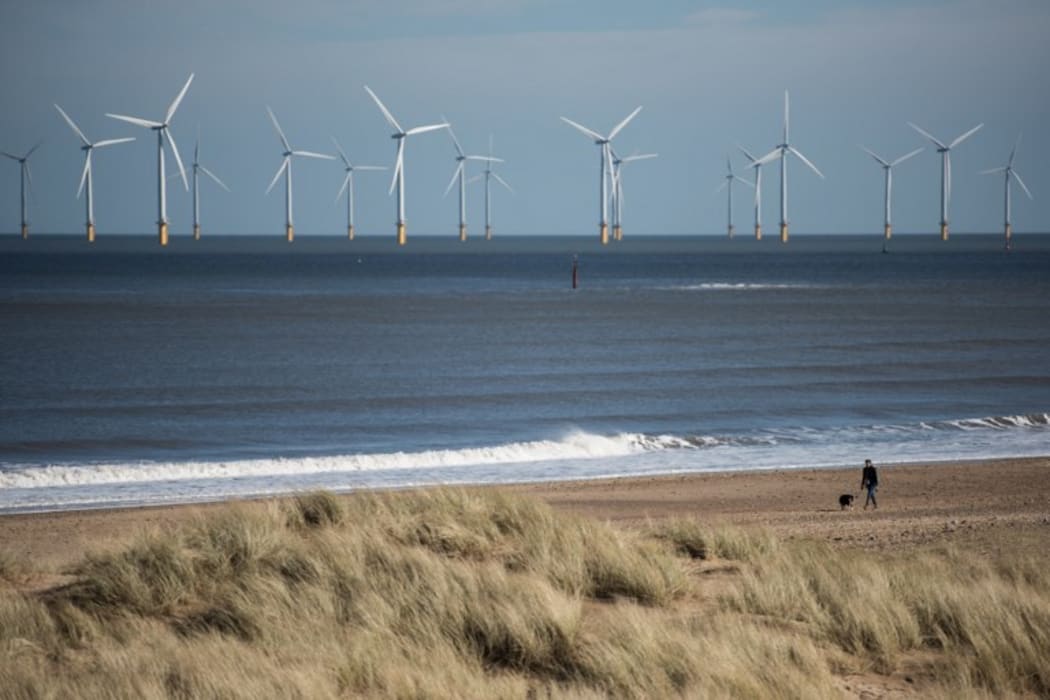The Government's flagship climate change legislation is scheduled to become law next year and will set New Zealand's long-term emissions goal.
It will also establish an independent Climate Change Commission.
New Zealand has already committed to transition to a net zero emissions economy by 2050.

The price of electricity generated by off shore wind has plummeted. Photo: AFP
But the IPCC's latest landmark global warming report says we need to act much quicker than that.
It might seem an impossible task but the UK has made deep cuts to its emissions in the last ten years. Ten years ago it passed the Climate Change Act.
Since then the UK has cut its overall emissions by 43 percent from 1990 levels even though the economy has grown by 70 per cent from that base year.
Chris Stark, chief executive of the UK's Committee on Climate Change, has been in New Zealand to address Auckland's Climate Change and Business conference.
He says the next ten to fifteen years are crucial, but the UK experience shows what can be done with a clear plan that gives business and communities the framework within which good decisions can be made.
New Zealand needs to make sure decisions made now don’t “bake in” high emissions in the future and New Zealand already has significant advantages over where the UK was a decade ago, he says
“In many ways we’ve been catching up with the New Zealand story, you start today with a really high degree of renewables in the electricity system.
“The challenge for us both is looking at ways we can electrify our economies to the greatest degree possible and rely on a clean electricity supply for that.”
The Climate Change Act marked the beginning of an era of policy certainty, he says. It uses a simple framework.
“There’s a long term target to reduce emissions - our baseline is 1990 - to reduce by 80 percent from their level in 1990 by 2050.
“The great foresight of the Climate Change Act was it was easily foreseen that governments would be unlikely to make all the right decisions to meet a long-term target unless there were a set of more medium-term targets.”
He says carbon budgets were the solution to the ‘Not In My Term of Office’ syndrome where politicians kick the climate policy tin down the road.
“The carbon budget, which we set every five years, looks out 12 years hence and takes us on what we regard as the cost effective path to that long term target for emissions reduction.”
Stark says this gives a “really good, transparent, strong governance framework.”
The UK government is required under the Act to formulate a plan to meet those carbon budgets.
“We audit that plan and report to parliament and that framework works extremely well. It has led to a fall in emissions in the UK of 43 percent since 1990 and it’s worth saying that in that period the UK economy grew by 70 percent.”
When the Act was introduced there were those that said the plan would shrink the economy, Stark says.
“We’ve bust what many of the naysayers said at the time that this would be a drag on the economy.”

Chris Stark Photo: Twitter
So how has the UK made these cuts? Wind both onshore and offshore, Stark says.
“Some very big and important decisions were taken particularly over the last ten years of the Climate Act to close coal plants using a carbon tax as the main mechanism to wean ourselves off coal and to replace that by low carbon electricity generation.
“Last year was the first year that we had a majority of electricity consumed being generated by low carbon means.”
Stark says ten years ago they underestimated the capacity of renewables in the UK and got their price predictions wrong too.
“Onshore wind is still the cheapest form of generation, and more recently offshore wind [has come on line] which has absolutely plummeted in price.”
New NZ book a call for action on climate change
The author of a new book about the impacts of climate change on coastlines says the sea level is rising more in the South Pacific than in other regions, ansd that urgent action is required on… Audio


